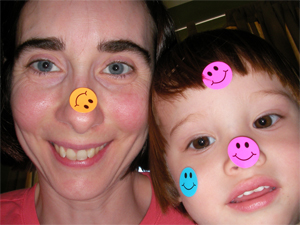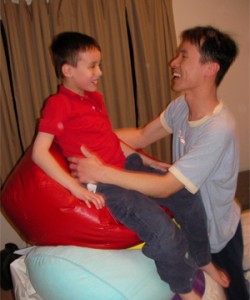
Therapy Tips  , Stanley Greenspan writes, “You’re always encouraging the child’s curiosity, interest and persistence to see how many circles of interaction you can get without the child getting too frustrated or annoyed. You want it to be pleasurable, but with a little oomph.” If you and your child end up laughing or hugging, then you are using non-verbal communication correctly.
, Stanley Greenspan writes, “You’re always encouraging the child’s curiosity, interest and persistence to see how many circles of interaction you can get without the child getting too frustrated or annoyed. You want it to be pleasurable, but with a little oomph.” If you and your child end up laughing or hugging, then you are using non-verbal communication correctly.
 , “Balancing means acting and communicating as much as your child...Balancing requires active and silent waiting for your child to take a turn, and also shortening the length of your turns. As you begin to do a little less, your child will do a little more by gradually increasing his number of turns in an interaction.”
, “Balancing means acting and communicating as much as your child...Balancing requires active and silent waiting for your child to take a turn, and also shortening the length of your turns. As you begin to do a little less, your child will do a little more by gradually increasing his number of turns in an interaction.”
 Collaborative play happens when partners contribute to a common goal, such as a pillow tower, a new muffin recipe or construction of a marble run. The partners challenge each other and change their plan as problems arise. The unstable pillow tower is a longtime favorite at our house, because it never works out quite the way we expected, but it always makes us laugh. Pretend play can be tricky, because it may be scripted and not reflect the child’s inner world; but it begins with re-enactments from the child’s own experience, and takes flight from there as the child tries on another persona. When my son’s development reached this stage, we were using blankets, scarves and pillows as props, and everything in our house found a new and exciting purpose.
Dr. Greenspan affirms, ““You are your child’s first friend and play partner.” This is where the fun begins. Now get down on the floor and play!
Collaborative play happens when partners contribute to a common goal, such as a pillow tower, a new muffin recipe or construction of a marble run. The partners challenge each other and change their plan as problems arise. The unstable pillow tower is a longtime favorite at our house, because it never works out quite the way we expected, but it always makes us laugh. Pretend play can be tricky, because it may be scripted and not reflect the child’s inner world; but it begins with re-enactments from the child’s own experience, and takes flight from there as the child tries on another persona. When my son’s development reached this stage, we were using blankets, scarves and pillows as props, and everything in our house found a new and exciting purpose.
Dr. Greenspan affirms, ““You are your child’s first friend and play partner.” This is where the fun begins. Now get down on the floor and play!
5 Steps To Getting Started With Play Therapy
After going through the process of diagnosis for a child with special needs, many parents are overwhelmed by the cost of private therapy and treatment. Then there’s the difficulty of scheduling therapies, and for some children, the trauma of separation from the parent during therapy. What if there was a therapy that could be done at home for free? What if there was a therapy that strengthens the bond between parent and child while also encouraging the child’s emerging independence? What if there was a type of therapy broad enough to assist with all types of special needs, but flexible enough to be tailored to a child’s specific goals in physical or occupational therapy, speech or social skills, sensory integration or emotional regulation? It would be perfect if such a therapy was also demonstrated to be effective in decades of scientific studies, right? Well, you’re in luck. With these five steps you can get started on play therapy today.1. Time Management
The funny thing about play therapy is that it requires the caregiver to change his or her own behavior before any changes are observed in the child. The first step is to create pockets of time throughout the day -- 10 minutes at first, but eventually up to 30 minutes -- with no distractions: no telephones or televisions, no errands or chores. Everything will have to to wait for 10 minutes so that you can prove to your child that your attention is undivided. My disabled son is 10 years old, and the one “reward” that he has always requested is time with a family member. He knows intuitively how valuable that time is.2. Non-Verbal Communication
The next change is to stop talking. Eye contact, facial expressions and gestures reinforce non-verbal relationship skills and build up the trust between two people. Try sneaking up melodramatically on your child and hiding yourself playfully, gasping in surprise at something the child did, putting stickers in unexpected places around your home or miming a glorious pratfall. Wait for the child’s response after each of your attempts to communicate. In his book Engaging Autism3. Declarative Language
When words become necessary, the most effective use of language is declarative or descriptive language instead of questions or commands. In her recent article on episodic memory, Linda Murphy states that declarative language can help another person “to learn how to observe, reflect, and share a subjective appraisal...It is by our moving from getting information to giving information that the child can truly learn to give back.” I freely admit that I still struggle with declarative language in everyday life, even though I see an immediate change in my son’s behavior every single time I use it. When I replace the sentence “Pick up your toys” with “I see so many toys on the floor,” I can see the wheels turning in my son’s mind as he follows my gaze and organizes the information. When I substitute the question “Whose birthday is coming?” with the statement “We’re having a party,” I am providing an opportunity for sharing emotion and building relationship skills. In another article Ms. Murphy points out that “declarative language does not require a verbal response. Rather, it invites experience-sharing, and provides an ideal social framework for later conversational interactions.” Declarative language encourages a sense of balance in a relationship -- when one person offers information, the other person will naturally want to add something to that information. James MacDonald explains in his book Play To Talk4. Joining and Challenging
The easy part of play therapy is joining my child in whatever he is doing. If he’s tapping his fork on the table, I pick up a fork and match his rhythm. If he’s riding his scooter back and forth through a mud puddle, I put on my mud boots and go through the puddle, too. If he’s squeezing out various lotions onto the bathroom counter, I’m squeezing right beside him. The hardest part of play therapy, according to Dr. Greenspan, is challenging the pattern of play and adding innovations to it. For example, I could change the rhythm of the fork on the table, or stop and restart the rhythm at a different pace, then wait for my son to follow. I could pretend to be afraid of the mud puddle and mime a request for help crossing it. I could stick my hand under the lotion bottle and start massaging the lotion up my arm or onto my son’s hand. Dr. Greenspan clarifies that the goal is “to become an enticing human plaything...Instead of interrupting or competing with the activity, you become part of it.”5. Collaborative and Pretend Play
It’s true that play therapy is time and labor intensive -- as all therapies are. The main advantage of play therapy with a parent is efficiency, since the parent automatically has a head start in knowing the child and having access to those fleeting “teachable moments.” Dr. MacDonald asserts that “...the best place to learn language, relationship skills and knowledge for everyday life is during everyday life...and because YOU, not a professional, are the one doing everyday life with your child, you have vastly more opportunities to help your child learn the knowledge he or she needs most.” The big payoff arrives when a child is ready for collaborative and pretend play, because this is how humans learn self-regulation and emotional expression. The parent is ready, too, with plenty of practice in non-verbal communication, declarative language, joining and challenging. Collaborative play happens when partners contribute to a common goal, such as a pillow tower, a new muffin recipe or construction of a marble run. The partners challenge each other and change their plan as problems arise. The unstable pillow tower is a longtime favorite at our house, because it never works out quite the way we expected, but it always makes us laugh. Pretend play can be tricky, because it may be scripted and not reflect the child’s inner world; but it begins with re-enactments from the child’s own experience, and takes flight from there as the child tries on another persona. When my son’s development reached this stage, we were using blankets, scarves and pillows as props, and everything in our house found a new and exciting purpose.
Dr. Greenspan affirms, ““You are your child’s first friend and play partner.” This is where the fun begins. Now get down on the floor and play!
Collaborative play happens when partners contribute to a common goal, such as a pillow tower, a new muffin recipe or construction of a marble run. The partners challenge each other and change their plan as problems arise. The unstable pillow tower is a longtime favorite at our house, because it never works out quite the way we expected, but it always makes us laugh. Pretend play can be tricky, because it may be scripted and not reflect the child’s inner world; but it begins with re-enactments from the child’s own experience, and takes flight from there as the child tries on another persona. When my son’s development reached this stage, we were using blankets, scarves and pillows as props, and everything in our house found a new and exciting purpose.
Dr. Greenspan affirms, ““You are your child’s first friend and play partner.” This is where the fun begins. Now get down on the floor and play! 


